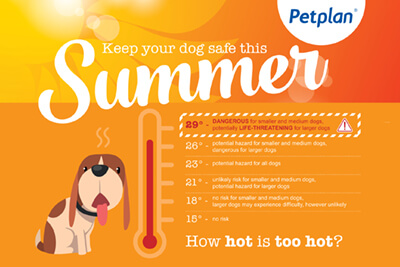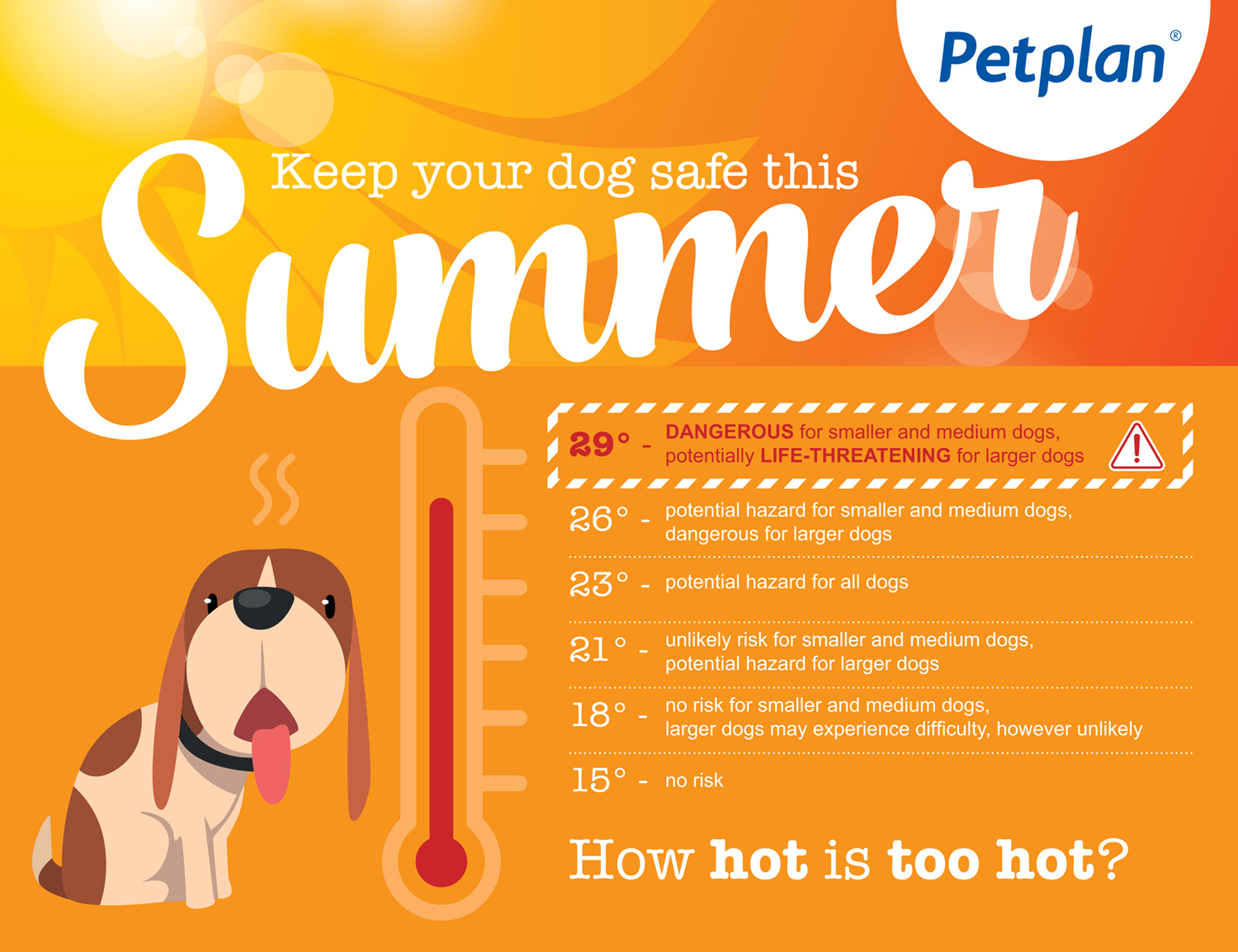Summer tips to keep dogs safe

Summer tips to keep dogs safe
Summertime is officially here, so for both you and your dog, it’s time to get outside and enjoy some quality time together in the sunshine. However, with the rising temperatures and extra time outside, there are a few things to be aware of to ensure that you and your pet have a fun, and ultimately safe, summer time.
Heat

Heat is the big one. Unlike humans, dogs do not sweat out their excess body heat, and what few sweat glands they have are not capable of dealing with higher heats, so instead they must lose heat via their mouths in the form of panting. If dogs become too warm, they’re much more prone to heat exhaustion, strokes, and even death.
- 15 degrees – no risk
- 18 degrees – no risk for smaller and medium-sized dogs but larger breeds may experience difficulty, however unlikely
- 21 degrees – unlikely risk for smaller and medium-sized dogs, but there is a potential hazard for larger dogs
- 23 degrees – potential hazard for all dogs
- 26 degrees – potential hazard for smaller and medium dogs, this can be dangerous for larger dogs
- 29 degrees – dangerous for smaller and medium dogs, potentially life-threatening for larger dogs
Risk can also be heightened if your dog suffers from obesity, if they are young or elderly, or if they are a brachycephalic (short-faced) breed. If unsure, always speak to a vet.
Breeds at a higher risk

Your dog's breed can play a huge part in how they deal with heat. Here are a few breeds of dog that are more susceptible to the heat and the breeds who need extra precaution:
Brachycephalic Breeds – due to their shorter noses, these dogs often struggle more with breathing which in turn makes it harder for them to regulate their body temperature
- Pugs, Boxers, Bulldogs, Boston Terriers, Chihuahuas, and King Charles Spaniels.
Thick Coated Breeds – These dogs often struggle with heat due to being bred to be more at home in colder climates, and as such, the heat can be a problem for them
- Huskies, St Bernards, Bermese Mountain Dogs, Alaskan Malamutes, Samoyeds and Chow Chows.
Black Coated Dogs – We tend not to wear black in the summer because it absorbs more light and heat. Unfortunately, black dogs can’t really change into something a little lighter, so be sure to pay extra attention to their condition.
Beat the Heat

When heat strikes, it’s important to know how to mitigate any of the potential risks to your pet.
- Plenty to drink – Keep them cool by ensuring you have water to hand at all times.
- Access to shade – Make sure your dog has a shady place to cool off.
- Avoid the midday sun – 11-3pm is when the heat of the sun is felt most, which also means it’s the most dangerous.
- Careful with cars – For all journeys make sure you have adequate air conditioning or roll the windows down. NEVER leave your dog in an unattended vehicle.
- Test the ground – place your hand on the ground for a few seconds before embarking on a walk. If it’s too hot for you, then it’s too hot for your dog.
Things to watch out for

Unfortunately, heat isn’t the only thing to watch out for in summer. Here are a few extra pieces of safety advice to keep you and your dog in good health and high spirits.
- Sunburn – Just because they’re hairy, it doesn’t mean your dog's skin is invulnerable to UV damage. Light coloured dogs are the highest risk. If you see blistering or crusting, ask your vet to check it out.
- Insects – Running and frolicking outside invariably means your dog is more likely to pick up parasites. Try to limit the chances of this happening by staying away from scrub grass and long grass fields, where the heat and moisture allow bugs, like potentially dangerous ticks, to thrive.
- Grass seeds – Check your dog’s paws as grass seeds and stems can get stuck in your pet's toes so be sure to avoid long grass and check for any problems after your dog has been outside.
- BBQs – Weather permitting, we love a good BBQ, but bits of detritus such as bones, corn, smoke and hot coals can prove hazardous to dogs, so vigilance is key.
- Adder bites – if you live in an area that has snakes, basking adders can lash out at curious noses. Always speak to your vet if you think your dog may have been bitten by a snake.
During periods of excessive heat, it’s important to be extra mindful of your pet's wellbeing, especially if they have any other conditions that could affect their health, such as inactivity, age, medical problems, or a history with heat stress. If you feel that anything is not right with your dog after some time in the sun, always contact your vet.
Related Articles
- Seven summer healthcare tips for dogs
- Seven summer healthcare tips for senior dogs
- How to keep your pet safe and well this summer
- How to keep your cat or dog safe in the summer months

